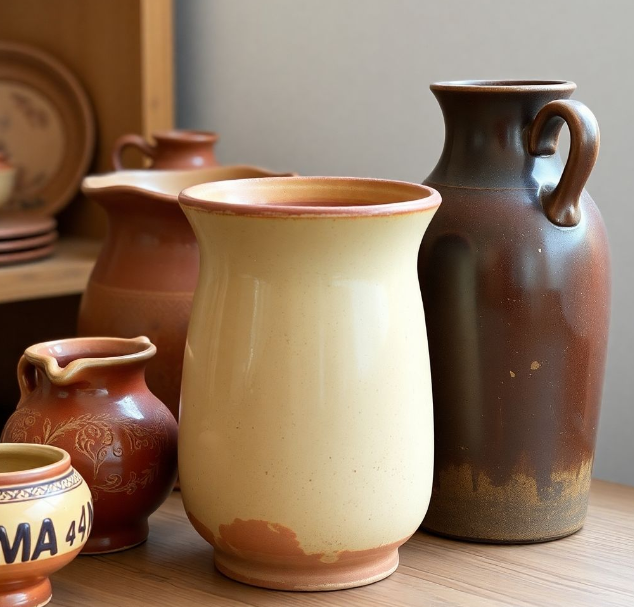
How To Tell If Pottery Is Old - A Comprehensive Guide To Identifying Vintage Pottery
Share
Decoding the Past: A Guide to Identifying Antique/Vintage Pottery

Unearth the secrets of the past and discover the thrill of identifying genuine antique pottery! This guide equips you with the knowledge and tools to navigate the world of vintage ceramics, transforming you from a curious admirer to a confident collector.
What is Considered Vintage Pottery?
Vintage pottery is pottery that is not new and is collectible, and is generally considered to be between 20 and 100 years old. However, the definition of vintage pottery can vary depending on the collector
Beyond Beautiful Decorations: The Allure of Antique Pottery
Antique pottery transcends mere decoration; it holds a rich history, whispers stories of bygone eras, and can hold significant value. From ancient Grecian urns to delicate porcelain teacups, each piece embodies the artistry and techniques of its time.
The Art of Identification: Unveiling the Secrets

Distinguishing genuine antiques from modern reproductions requires a keen eye and a multi-faceted approach. Here's a breakdown of key methods to decipher the whispers of the past:
1. Visual Clues: Examining the Pottery's Appearance
- Surface Texture and Glaze: Look for signs of age like crazing (fine hairline cracks), discoloration, or uneven glaze application. Modern pottery often boasts flawless finishes.
- Color and Pigmentation: Color palettes can offer valuable clues. Historically, vibrant blues and greens were common in the 18th century, while earth tones dominated earlier periods. Over time, colors may fade, acquiring a subtle patina indicative of age.
-
Shape and Style: Familiarize yourself with the evolution of pottery styles. Art Deco pieces feature sleek lines and geometric shapes, while Colonial pottery often has rustic, functional forms. Recognizing these stylistic shifts aids in dating the pottery.
2. Material Composition and Manufacturing Techniques
-
Clay Type and Composition: Older pottery typically uses natural clays with varying appearances. Understanding the properties of clays from different regions can provide valuable insights. Scientific tests like X-ray diffraction can further identify clay types and age.
- Manufacturing Marks: Maker's marks, stamps, or inscriptions often found on the base of the pottery, can reveal a wealth of information. Researching notable potters and their signatures can be a great way to date a piece.
- Construction Methods: Historically, pottery was made using various techniques. Hand-built pottery, often uneven in shape, resembles early production styles, while wheel-thrown pieces gained popularity later. Learning to identify these methods will help in your assessment.
3. Historical Context

- History of Pottery Styles: Familiarize yourself with the evolution of pottery styles throughout history. This will help you recognize characteristics of different eras. For example, Art Deco pieces often feature sleek lines and geometric shapes, while Victorian pottery may display ornate floral motifs.
- Dating Pottery by Style: Certain styles and decorative motifs are indicative of specific time periods.
4. Tools and Resources
- Best Books on Pottery Identification: Invest in books on pottery identification and collecting.
- Online Resources: Explore online databases and websites dedicated to antique pottery and collectibles.
- Museums with Pottery Collections: Visit local museums with significant pottery collections to learn from experts and see authentic pieces firsthand.
5. Value and Appraisal
- Factors Affecting Pottery Value: Condition, rarity, provenance (history of ownership), artist attribution, and historical significance all play a role in determining the value of a piece.
- How to Appraise Old Pottery: Consult with experienced appraisers or antique dealers for professional valuations.
- Selling Antique Pottery: If you decide to sell, research reputable auction houses, antique dealers, and online platforms specializing in vintage and antique items.
6. Detecting Forgeries and Reproductions
- Common Forgery Techniques: Be aware of common forgery techniques, such as artificially aged glazes or mass-produced imitations.
- Identifying Signs of Modern Manufacturing: Modern pottery may exhibit characteristics like overly smooth glazes or perfectly uniform shapes that are less common in older pieces.
7. Advanced Authentication Methods
-
Scientific Methods: Several scientific methods exist for dating pottery. Techniques like X-ray fluorescence measure the chemical composition, while thermoluminescence dating can determine when clay was last heated. These methods offer credibility to your assessment.
Conclusion
Identifying old pottery requires a combination of knowledge, observation, and research. By carefully examining the materials, craftsmanship, markings, and historical context, you can develop a keen eye for authentic antiques. Remember to always consult with experts and conduct thorough research before making any significant purchases or valuations.
Explore Further: Explore Our Blog for more articles on vintage decor and collecting.
Interested in vintage pottery? Click here to shop our curated collection of vintage pottery!
